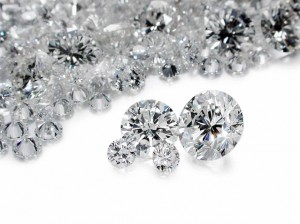If you love the thought of a beautiful high quality diamond engagement or anniversary ring but are concerned about the price, man-made diamonds can be a fantastic (and affordable) alternative to diamonds. These stones can beautifully duplicate the look of natural diamonds without the cost and ethical issues associated with diamond mining. But what exactly are man-made diamonds? Can they really be passed off as diamonds? Where are they sold–and how much do they cost? There can be a lot of confusing terminology out there, so it is a good idea to get the basics down before beginning the jewelry purchasing process.
What Exactly Are Man Made Diamonds? What Are Diamond Simulants?
The terminology can be confusing for the average consumer, considering there are so many interchangeable words used to describe artificial gemstones. Some of the most popular words or phrases include: lab-created, diamond simulants, synthetic diamonds, hybrid, artificial diamonds, cultured, imitation or simulated diamonds. Bottom line? Anything that is listed as a “synthetic diamond” is literally a diamond created in the lab, with all of the same properties as a mined diamond. There are only a handful of synthetic diamond manufacturers in the United States, and they cost approximately 30% less than a mined diamond. Click here for more information on true synthetic diamonds.
Generally speaking, anything that is not a synthetic diamond will be comprised of some variation of cubic zirconia. Some companies may suggest they sell a special type of diamond coating or powder on their stones (like diamond hybrids or special patent-pending stones), but in reality, all diamond simulants are a type of cubic zirconia. The confusion arises because these stones are indeed made in labs (man-made). The sticking point is in the terminology due to the zirconia jewelers being wary of using the term “cubic zirconia” and its stigma. By offering slightly confusing product information and descriptions of their stones, many are simply trying to shy away from what all diamond simulants are made of: cubic zirconia.
To sum it up, synthetic diamonds are man-made diamonds grown in a lab with the same chemical, physical and optical properties and structure of natural diamonds. Aside from their origin, they are essentially identical to mined diamonds. It is important to note that synthetic diamonds are not to be confused with diamond simulants, which are distinctly different in composition, price and their appearance under a jewelers loup. However, simulants are beautiful in their own right and often look just as stunning in high-quality settings.
Man Made Diamond Stone Quality
With mined diamonds, the 4 Cs are an important way to judge the quality and value of each stone. Because diamonds are created in the earth, they are subject to the various degrees of impurities and imperfections (often called inclusions). Man-made, lab created diamonds are also graded by the 4 Cs. The main difference between the two? They are created in a controlled and monitored lab environment, they come out on top of all the ratings and are more perfect than their mined counterparts in clarity and color.
Benefits of Man Made Diamonds
- More affordable than mined diamonds.
- Consumers are able to purchase a higher quality color and clarity for a fraction of the price of flawless mined diamonds.
- Come in a variety of colors and shapes.
- Ethical and eco-friendly.
Click here to get a list of man-made (synthetic) diamond manufactures, and click here to get a list of popular diamond simulant jewelers.
_______________________________________________
If you are getting engaged and are interested in getting the look of a mined diamond at a more affordable price, man-made diamonds are a fantastic choice. Whether the stones are formed deep within the earth or above ground in a special laboratory, the purpose of gemstones are fundamentally the same: to be beautiful, enjoyed and admired by all.








